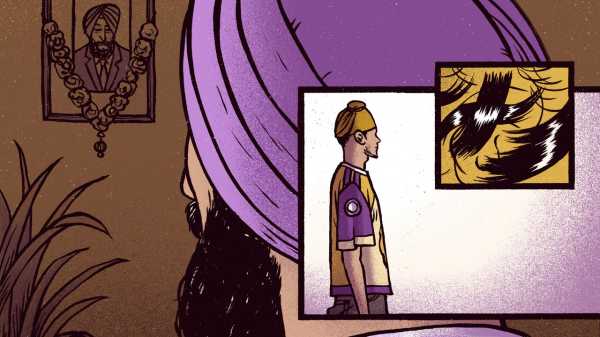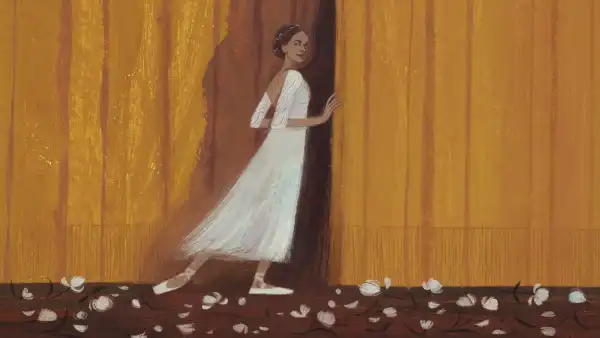
Save this storySave this storySave this storySave this story
On a spring day in 1993, my mom drove me to a hair salon in Linden, New Jersey, and got me a haircut. It was my first. I wasn’t yet three. She knew that she was jeopardizing her marriage. She knew that she was crossing a line my dad considered nonnegotiable.
The question of my hair had weighed on her since before I was born. Like my father, she is an adherent of Sikhism, a South Asian religion that emerged in Punjab in the fifteenth century. Sikhs cannot cut their hair. Men are supposed to wear turbans. Some families are looser about the rules, but my mom’s was not. After one of her great-uncles was forced to cut his hair and abandon his turban, in the mid-twentieth century, he was beset by a shame so unbearable that he killed himself. Yet my parents, both Indian immigrants, knew few Sikh boys in the United States who had been raised with long hair. So when it was time to send me to preschool, my mother said, “It became, like, Oh, my God. I cannot have this kid going there with a joora,” or topknot, “because I was so afraid kids would tease you.”
The fallout was painful. My mom had a handful of family members in the United States. A few supported her; many did not. An uncle called to say that he couldn’t accept her decision. A distant aunt berated her during a social visit. Her marriage descended into a state of tense fragility, “not too different from when people get divorced,” she said.
My parents hosted my third-birthday party shortly after. I don’t remember it, but I watched the tape during a trip home from college. It opens in the back yard of the house where I spent my first five years, in Woodbridge, New Jersey. The footage is grainy and bleached out. Seven Sikh men, five in turbans, sit in a loose semicircle on white lawn chairs. A Punjabi song blares in the background, the singer’s voice jubilant and winding through verses I can’t quite discern. The camera zooms in on my father. He wears a loose-fitting, short-sleeved shirt with a geometric print. His turban is black and tied in the Kenyan style, a smooth, tailored look that originated among Sikhs who immigrated to British East Africa. His mannerisms—especially the way he speaks with an open hand that closes whenever he finishes a point—are instantly familiar.
A small head with a bowl cut bobs across the bottom of the screen. The camera follows. The head belongs to a boy. He’s dressed in Nickelodeon colors: a bold yellow polo with red-and-green lining; bright-blue checkered shorts that hang past his knees. He climbs off his kiddie car and reaches for another kid’s ball and plastic cricket bat. Someone calls his name, and he turns. I saw him—this boy whose face looked like mine and who answered to my name. And, with my mom sitting next to me, I started to cry.
My parents never cut my hair again. My dad persuaded my mom to give long hair another try. I was happy, he said. No one was hassling me, and, if they did and I was upset about it, he promised to support a haircut.
My mom’s fears of bullying turned out to be unnecessary. Kids were more accepting than she’d anticipated, at least in our pocket of New Jersey suburbia. But my hair—and the patka, or proto-turban, that I wore over it—brought other complications. Without the cue of a gendered haircut, I was often mistaken for a girl. People stared a lot. When I told my mom this, she suggested that I glare back until they looked away. Over hundreds of showdowns, I honed an expression somewhere between blankness and defiance, not unlike today’s “resting bitch face.” Uncomfortable moments were transformed into confidence boosts as I stared down anyone whose gaze lingered, many of them adults.
At school, I learned that people asking, “Why do you wear that?” are satisfied when they’re told, “Because of my religion.” And I learned that much about my hair—its length, the thick braid that my mom prepared every day, its perch atop my head—was fascinating to other kids, and that they wanted to see it. In second or third grade, a classmate, Josh, pulled off my patka and got in trouble. But I remember feeling that the adults had misread the situation. Josh and I were friendly; I hadn’t felt violated. To the contrary, I think I had given him permission.
The patka was heavier in middle school. The infatuations of late elementary school solidified into something different, something more intense. Other kids were flirting, swapping AIM usernames, and calling each other boyfriend and girlfriend. The halls were choked with hormones. Girls started wearing plunging V-neck shirts over tank tops, and sweatpants with “JUICY” across the butt. I had crushes, strong ones, that nearly possessed me, but I didn’t know where I stood. I heard another sixth grader, a girl who I found beautiful and unattainable, say that she was dating an eighth grader who had a scar where a bear had attacked him. At bar and bat mitzvahs, my classmates started grinding to Nelly and Lil Jon, while I, with my clip-on tie, stood on the sidelines, sipping Sprite like it was Scotch and trying not to sweat through my dress shirt. Friends nudged me to ask girls to dance, but it felt impossible.
I suspect that such awkwardness is pervasive in middle school. Yet my patka, this thing that made me look like a girl and that strangers gawked at, seemed like a disqualifier. It wasn’t so much that I felt unattractive as that I felt outside the sphere of attraction, as if I were a non-player character in a video game about kissing, mostly there to deliver jocular asides between make-out sessions.
In a new book, “The Turban: A History from East to West” (Reaktion), Chris Filstrup and Jane Merrill trace the history of head-wrapped cloth, from sixth-century Bedouins protecting themselves against the desert sun to Sarah Jessica Parker donning a gold-silk wrap designed by Ralph Lauren. As its title promises, the book is overwhelmingly about the migration of the turban into the West, with a large portion focussing on how an Arabian adornment, through the influence of Islamic empires like the Ottomans, came to penetrate European and Euro-American art and fashion. The list of figures who have worn a turban includes Jane Austen, Lord Byron, Elizabeth Taylor, Queen Elizabeth II, Simone de Beauvoir, the Fourth Earl of Sandwich, First Lady Dolley Madison, First Lady Mamie Eisenhower, Napoleon’s sister Pauline and his wife Joséphine, and the subject of Vermeer’s seventeenth-century portrait “Girl with a Pearl Earring.” Andy Warhol painted a watercolor of a cat in a turban. Yves Saint Laurent sent turbans down the runway with flowing gowns. When the New Yorker writer A. J. Liebling arrived to interview Édith Piaf before her American début, he accidentally woke her up. She left to change, then reëmerged, turban in place.
“The Turban” exposes a paradox. I can’t imagine ever surrendering my turban. It’s become soldered to my identity, serving as both the ultimate in-group badge and a versatile stylistic accessory: eye-catching, a bit exotic, an opportunity to add color and flair. But I haven’t forgotten how hard it can be to carry. Like a huge zit or a malformed nose, it becomes a lightning rod for insecurities, the thing to be blamed after slights and uncomfortable experiences. I’ve been lucky to escape bullying, but according to one study nearly eighty per cent of Sikh boys with head coverings in the United States report having the opposite experience. This is why it’s jarring to see the turban featured on catwalks and red carpets and in Renaissance courts. How can something that once threatened to destroy my parents’ marriage, something that sparks feelings of anxiety and apartness, be worn so casually by others? Why are symbols often the most burdensome for the people who hold them most dearly?
My great-grandfather died hunting lions, or so I was told growing up. The incident occurred in the scrublands of western India, in the final years of British rule. He was out with his oldest son, my maternal grandfather, who was then around twenty. My great-grandfather was handling his rifle, possibly cleaning it, when the mechanism misfired and shot him in the arm. My grandfather ran to his father, pulled off his turban, and tied it around the wound. He lifted him onto his horse and rode to a hospital, his unshorn hair exposed to the world. But the bleeding didn’t stop, and his father died.
I have always had a complicated relationship with this story. I understand that the event was traumatic, that it haunted my grandfather for the rest of his life, leaving him not only fatherless but, as the oldest child, a surrogate parent to six siblings, including a sister who was still in the womb. Although I never met him—he died five years before I was born—my mom told me that he’d kept a photograph of his father in the house, bowing to it often, even after everyday milestones, like buying new clothes.
But that recognition of loss coexists with pride. As a young kid, I fixated on the lions. I was small, bookish, and obsessed with Asian and African mammals—and I loved envisioning my ancestors on horseback, fearless and regal, stalking the most royal of beasts. “My grandfather died hunting lions,” I would say, mixing up which forebear it was and either forgetting or deliberately excluding the other details. As I got older, the moment of the unwrapped turban grew more prominent in my imagination. Few objects are more sacred to a Sikh man than his turban; using it as a bandage exemplified devotion and compassion, but also strength. I wore a turban, too, and the story imbued the item with a dignified masculinity, positioning me in a stately, almost majestic lineage.
Such grandeur was the point, originally. Modern portraits of the founder of Sikhism, Nanak Dev, show him beturbanned, but historians such as Jvala Singh, at Berkeley, insist that this is a historical misrepresentation. The first five gurus, a succession of prophet-leaders, likely donned the seli topi, a woven cap worn by Hindus and Muslims and associated with humility and spiritual living. The turban, Singh argues, wasn’t widely adopted until the time of the sixth guru, Hargobind. Responding to persecution by India’s Mughal rulers—and the torture and execution of his father—Hargobind militarized Sikhism. He carried two swords, solicited offerings of arms and horses, and swapped the saintly topi for the kingly turban. Roughly a century later, in 1699, the tenth guru prohibited baptized Sikhs from cutting their hair, and the turban became enshrined as a martial and spiritual requirement for men.
Valor and nobility were recurring themes in my childhood. At Sunday school, we learned how Mughal élites monopolized the turban, and how Sikhs usurped it and bestowed it on themselves. Whenever I scraped my knee and cried, my father would remind me that I am a Singh, a lion. My parents—with degrees in civil engineering and English literature—aren’t exactly warlike, yet watch that video from my third birthday long enough and you’ll notice a shield with a pair of crossed swords hanging like a trophy on our living-room wall.
Meaning rarely travels intact, however. Strangers and new classmates didn’t think of badass lion hunters or Mughal-era warriors when they first saw my patka or, later, the full turban. Rather, they tended to infer piety and cultural parochialism, figuring that anyone dressed like me must be serious about God and bound to tradition. To be fair, fellow-Sikhs also infer devotion and discipline, although these are neither the only readings nor the most common. We all know mone, or men with cut hair, who read scripture every day, as well as full-bearded sardars who drink whiskey, spend Saturday nights flirting at hookah lounges, and haven’t seen the inside of a temple since their sister’s wedding. We all understand that the decision to maintain Sikhism’s external markers reflects countless considerations, including faith, pride, family pressure, the inertia of identity, and the comfort of instant belonging—most of which can remain frustratingly invisible to the Western mainstream.
A straightforward response to carrying something so burdensome is to drop it. I’ve seen many young Sikhs go this route. After I started college, a kid I had grown up with who spoke much better Punjabi than I, and whose traditionalist father taught us Sikh history, appeared in Facebook photos with cropped hair and a popped collar, as I remember it. My cousin’s best friend, who was featured on educational posters informing the public about Sikh headwear, experimented with a man bun in high school, then cut his hair. I get why they did it. When you’re misread before you speak, scrapping the visual script can seem like the only way to reclaim agency. “My confidence is dying because I feel so trapped in turban that it limits my potential,” one college student wrote, in a Reddit post titled “I’m on the verge of cutting hair.” A seventeen-year-old Sikh born and raised in the U.S., after getting a crewcut with faded sides, explained, “It’s been a consistent source of misery for me, yes obviously because of social isolation.”
Another option is to counterbalance the turban’s weight, to dress oneself in a constellation of symbolic imagery so expressive and emphatic that the meaning of the turban is altered or overwhelmed. Such compensatory identity signalling is widespread. A young Black man might whistle Vivaldi to put passersby at ease. An Asian American high schooler might break-dance to defy stereotypes of nerdiness. The marginalized and diasporic learn the gestures that best reroute perception. Like garam masala thrown into a curry, these choices don’t erase the base ingredients so much as augment and redefine them.
For many turbanned Sikhs, this has often meant looking to hip-hop and Black culture. Scholars like Conner Singh VanderBeek, an ethnomusicologist at Davidson College, and Aranveer Singh Litt, a Ph.D. student in communication arts at the University of Wisconsin-Madison, have studied why diasporic Punjabi Sikhs gravitate toward hip-hop, citing its warrior ethos, politics of resistance, and reflections on racial profiling and systemic injustice. But there’s also the desire to be cool, to be seen as more than just a brown dude with religious head garb. I remember when kids my age—including the son of one of our temple’s musicians—started showing up in gold chains, baggy jeans, and basketball jerseys, speaking a hard blend of village Punjabi and slang borrowed from “106 & Park.”
After I switched schools in eighth grade, I, too, moved in this direction, quoting OutKast, then Tupac, then the Soulquarians’ discography, all the while rocking Timberlands and baggy, zip-up hoodies. I loved the music, yet—and I admit this with some guilt—I also liked the version of myself that it projected: the little chocolate boy whose car bumped Talib Kweli as his dad dropped him off each morning. The fit was always awkward, though, not to mention offensive, something I learned when a Black classmate asked me why I felt comfortable building my identity around a culture that wasn’t mine.
In college, I developed a different aesthetic assemblage. I had, by this time, progressed from the patka to the dastar, the full turban, wearing a style similar to my father’s but higher on the head and more voluminous. This was the beginning of the Obama era. Ironic hipsterdom was ascendant, although it was countered by a subcultural trend that revelled in celebrationist joy, psychedelic absurdity, and whimsical transcendence—the cult of Dan Deacon, Devendra Banhart, and Animal Collective. Everything was handmade, loop-pedalled, a little messy, a little lo-fi. I found myself in a social scene that valued creativity, self-expression, iconoclastic sincerity, and the cultivation of interesting-ness. It was often exhausting—a performed individuality—yet I morphed to accommodate it. My mother tie-dyed a turban purple for my nineteenth birthday; months later, my friend Arlando screen-printed zigzags onto another one. Though my fashion became bolder—purple corduroys, tiny floral-patterned shorts, an oversized sweatshirt with my face printed on the left breast like a logo, everything patched and re-sewn to oblivion—I also became aware of the materiality of my headwear, how it could be reimagined and absorbed into this newer, more florid self. I stamped a turban with hippos’ faces, screen-printed another with hand-drawn paisleys, and began a practice of turban-dyeing and turban-painting that has continued to this day.
The result was a semiotic pivot. Like a chameleon dropped into a pile of Technicolor tapestries, my headwear announced a reimagined self—less pious conservatism, more ecstatic singularity. It was around this time that I watched the video of my third birthday. My mom asked me why I was crying, and I lied, saying something about being disappointed that I had tried to take the cricket bat from my friend. The truth was that I didn’t have the words to express what I was feeling. The sight of me with cut hair had been strange and jarring, like spotting a doppelgänger of yourself doing something out of character and obscene. My hair and turban were so foundational to my story—gravitational centers around which I had constructed myself—that the kid on the screen, so obviously me, also seemed obviously not me.
I once thought that symbols like my turban felt heavy because of other people. They stereotype; they assume; they stare. But none of those responses would occur without the turban mattering to me. I have chosen to carry it despite being gawked at, misread, feminized, and cast as unreasonably devout. Strangers may not know why I wear it, but they sense that it isn’t arbitrary. This is what makes my turban different from Lord Byron’s or Sarah Jessica Parker’s, what happens with any symbol that is important to the person carrying it. It is burdensome not in spite of its meaning but because of it. ♦
Sourse: newyorker.com







